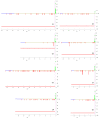Decoding of Turning Intention during Walking Based on EEG Biomarkers
- PMID: 35892452
- PMCID: PMC9330787
- DOI: 10.3390/bios12080555
Decoding of Turning Intention during Walking Based on EEG Biomarkers
Abstract
In the EEG literature, there is a lack of asynchronous intention models that realistically propose interfaces for applications that must operate in real time. In this work, a novel BMI approach to detect in real time the intention to turn is proposed. For this purpose, an offline, pseudo-online and online analysis is presented to validate the EEG as a biomarker for the intention to turn. This article presents a methodology for the creation of a BMI that could differentiate two classes: monotonous walk and intention to turn. A comparison of some of the most popular algorithms in the literature is conducted. To filter the signal, two relevant algorithms are used: H∞ filter and ASR. For processing and classification, the mean of the covariance matrices in the Riemannian space was calculated and then, with various classifiers of different types, the distance of the test samples to each class in the Riemannian space was estimated. This dispenses with power-based models and the necessary baseline correction, which is a problem in realistic scenarios. In the cross-validation for a generic selection (valid for any subject) and a personalized one, the results were, on average, 66.2% and 69.6% with the best filter H∞. For the pseudo-online, the custom configuration for each subject was an average of 40.2% TP and 9.3 FP/min; the best subject obtained 43.9% TP and 2.9 FP/min. In the final validation test, this subject obtained 2.5 FP/min and an accuracy rate of 71.43%, and the turn anticipation was 0.21 s on average.
Keywords: ASR; BMI; EEG; H∞; intention turn direction; real time.
Conflict of interest statement
The authors declare no conflict of interest.
Figures






References
-
- Costa Á., Asín-Prieto G., González-Vargas J., Iáñez E., Moreno J.C., Del-Ama A.J., Gil-Agudo Á., Azorín J.M. Biosystems and Biorobotics. Volume 16. Springer; Berlin/Heidelberg, Germany: 2017. Attention level measurement during exoskeleton rehabilitation through a BMI system; pp. 243–247. - DOI
-
- Quiles V., Ferrero L., Ianez E., Ortiz M., Megia A., Comino N., Gil-Agudo A.M., Azorin J.M. Usability and acceptance of using a lower-limb exoskeleton controlled by a BMI in incomplete spinal cord injury patients: A case study; Proceedings of the Annual International Conference of the IEEE Engineering in Medicine and Biology Society; Montreal, QC, Canada. 20–24 July 2020; pp. 4737–4740. - DOI - PubMed
-
- Millán J.D., Rupp R., Müller-Putz G.R., Murray-Smith R., Giugliemma C., Tangermann M., Vidaurre C., Cincotti F., Kübler A., Leeb R., et al. Combining brain-computer interfaces and assistive technologies: State-of-the-art and challenges. Front. Neurosci. 2010;4:161. doi: 10.3389/fnins.2010.00161. - DOI - PMC - PubMed
-
- Ortiz M., Nathan K., Azorín J.M., Contreras-Vidal J.L. Handbook of Neuroengineering. Springer; Singapore: 2021. Brain-Machine Interfaces for Neurorobotics; pp. 1–41. - DOI
MeSH terms
Substances
Grants and funding
LinkOut - more resources
Full Text Sources

